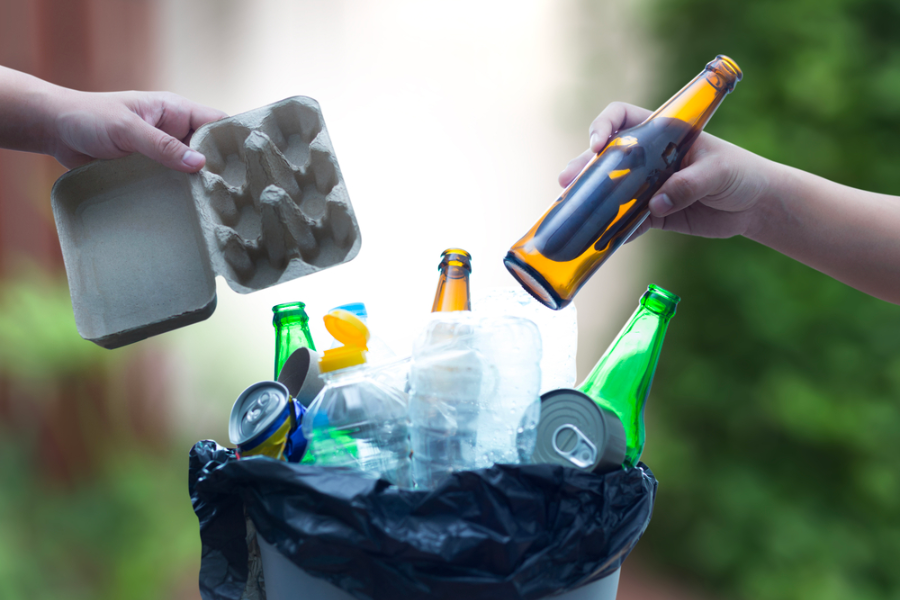
Three-quarters of states and provinces surveyed by the Northeast Recycling Council reported the use of recovered glass as alternative daily cover at landfills. | One Photo/Shutterstock
This story has been updated.
There may not be solid data available on the amount of MRF glass used as alternative daily cover at Northeast landfills, but a recent survey suggests the low-value end use is fairly common.
A recent report from the Northeast Recycling Council (NERC) explored the use of crushed glass bottle and jar scrap as alternative daily cover (ADC), which is a layer of material placed on top of landfills at the end of each day to help keep pests away from putrescible material, reduce odors and prevent garbage from blowing away.
“The report provides great insight into MRF glass that is not reaching manufacturers for making new products and is instead being used at landfills – the lowest-value end use with the least environmental benefits,” Mary Ann Remolador, assistant director of NERC and Glass Committee staff lead, stated in a press release.
NERC’s Glass Committee compiled the report, which was based on a survey of 11 Northeast states and the province of Quebec. Three-quarters of the states/provinces surveyed reported that glass collected for recycling is being used as ADC. Those were Connecticut, Maine, Massachusetts, New Hampshire, New Jersey, New York, Pennsylvania, Rhode Island and Quebec. Delaware, Maryland and Vermont reported that glass is not being used for ADC.
The study found not all jurisdictions are disclosing to residents that glass may be going to ADC.
The survey also found that most jurisdictions don’t consider ADC recycling.
The Glass Committee also concluded a dearth of data means it’s not possible to know how much MRF glass is being used as ADC in the region. It also concluded that not all jurisdictions are proactively disclosing to residents that glass they put in recycling bins may be going to ADC.
“While some states take a proactive approach to ensuring end uses for recycled material are publicly available, others do not readily share this information,” the release noted.
NERC pointed to a few factors leading to MRF glass being deposited at landfills. First, the quality of material collected outside of deposit systems is generally too poor for manufacturers to use without additional cleaning and sorting by a beneficiation facility. At the same time, the Northeast region lacks enough beneficiation facilities to serve the whole region. And when MRF glass is full of heavy contamination, it’s not generally economically feasible to pay to ship it more than a couple hundred miles for processing, the report stated.
NERC called for better data collection on end uses for MRF glass, as well as further investments in sorting infrastructure.
“More beneficiation facilities capable of cleaning MRF glass are needed throughout the region to make the glass economical for use as a manufacturing feedstock,” according to the release.
In a statement in response to the report, Scott DeFife, president of the Glass Packaging Institute, said he appreciated that the NERC report highlighted an ongoing challenge in the region.
“GPI agrees with the report’s conclusion that more investment in glass recycling infrastructure would help decrease material contamination, and increase the volume of quality glass suitable to be recycled into new containers,” DeFife stated. “ADC should only be allowed after all other end market options for glass sorted by MRFs are explored. Local governments and states should re-consider providing any diversion or recycling credits to entities using glass as a landfill cover substitute, or for disposal of glass in any similar manner.”
He also pointed to expanding bottle deposit programs to generate more clean recovered glass.
“Clean source-separated glass from the region’s deposit return programs has good, positive end markets, and GPI recommends states with bottle bill recycling programs expand to include as much glass beverage packaging as possible,” DeFife said. “This will allow existing networks of bottle processing facilities to get more of the region’s post-consumer glass back into the supply chain. Any state without a deposit return system should consider one if they are also considering extended producer responsibility policy.
“Lastly, the states in the region should consider a regional compact to assist in the siting and support for new multimodal regional glass processing facilities that can handle MRF glass, to deal with the region’s non-bottle bill glass,” he added.
This story has been updated with a statement from Scott DeFife of the Glass Packaging Institute.


